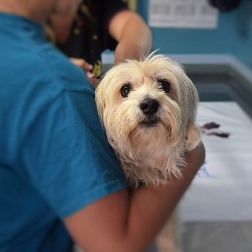How to Enroll In a Vet Tech School near Navajo New Mexico
 Achieving your lifelong goal of working with and helping animals by enrolling in a veterinary technician program near Navajo NM might at first seem like an overwhelming task. After all, you have to find and enroll in a college that will deliver the proper training so that you can succeed as a veterinary technician. But just how do you tackle analyzing and comparing programs so that you can make the proper choice? Many aspiring students begin their due diligence process by looking for schools that are close to their homes. When they have located some area colleges, they find out which ones have the most affordable tuition and focus on those. Although expense and location are significant concerns when comparing vet tech schools, they are not the only important ones when making your evaluations. Factors such as accreditation and internship programs should be looked into also. The main idea is that there are questions you need to be asking the vet tech programs you are looking at before you make a final selection. We have presented several in this article in order to help get you started, but before we discuss them we’ll go over the different responsibilities of vet techs and the training alternatives available.
Achieving your lifelong goal of working with and helping animals by enrolling in a veterinary technician program near Navajo NM might at first seem like an overwhelming task. After all, you have to find and enroll in a college that will deliver the proper training so that you can succeed as a veterinary technician. But just how do you tackle analyzing and comparing programs so that you can make the proper choice? Many aspiring students begin their due diligence process by looking for schools that are close to their homes. When they have located some area colleges, they find out which ones have the most affordable tuition and focus on those. Although expense and location are significant concerns when comparing vet tech schools, they are not the only important ones when making your evaluations. Factors such as accreditation and internship programs should be looked into also. The main idea is that there are questions you need to be asking the vet tech programs you are looking at before you make a final selection. We have presented several in this article in order to help get you started, but before we discuss them we’ll go over the different responsibilities of vet techs and the training alternatives available.
The Job of a Vet Tech in Navajo NM
 Among the initial decisions that you will need to make is whether you desire to train as a vet assistant, technician or technologist. Part of your decision may be based on the amount of time and money that you have to commit to your education, but the principal factor will undoubtedly be which specialization appeals to you the most. What technicians and assistants share in common is that they both work under the immediate guidance of a practicing and licensed veterinarian. And while there are a number of jobs that they can perform within the Navajo NM veterinary clinic or hospital, they can’t prescribe medications, diagnose ailments, or conduct surgeries. In those areas they can only provide assistance to a licensed veterinarian. There are technicians and technologists that work exclusive of the standard vet practice, for example for animal shelters, zoos or police departments. Let’s take a look at the duties and education prerequisites for each specialization.
Among the initial decisions that you will need to make is whether you desire to train as a vet assistant, technician or technologist. Part of your decision may be based on the amount of time and money that you have to commit to your education, but the principal factor will undoubtedly be which specialization appeals to you the most. What technicians and assistants share in common is that they both work under the immediate guidance of a practicing and licensed veterinarian. And while there are a number of jobs that they can perform within the Navajo NM veterinary clinic or hospital, they can’t prescribe medications, diagnose ailments, or conduct surgeries. In those areas they can only provide assistance to a licensed veterinarian. There are technicians and technologists that work exclusive of the standard vet practice, for example for animal shelters, zoos or police departments. Let’s take a look at the duties and education prerequisites for each specialization.
- Vet Assistants in most cases will have gone through a structured training program, either as an apprentice or intern in a vet clinic or hospital, or by graduating from a certificate program at a trade school or community college. As the name implies, their job function is to assist the vets and vet techs in the completion of their duties. Usually they are not involved with more involved tasks, such as assisting with surgeries. A few of their usual duties may include working at the front desk, cleaning and preparing exam rooms and equipment, or handling animals during examinations.
- Vet Technicians receive more advanced training compared to assistants and usually acquire a 2 year Associate Degree, preferably from an American Veterinary Medical Association (AVMA) accredited program. They are in a fashion the vet equivalent of medical nurses, since their fundamental job duty is to assist vets with diagnosing and treating animal patients. Where they differ from vet assistants is that they are included in more involved functions, such as assisting with surgical procedures or providing medicine. All states currently mandate that vet technicians pass a credentialing exam for either certification, registration or licensing.
- Vet Technologists are similar to veterinary technicians and essentially carry out the same job functions. They are mandated to earn a Bachelor’s Degree in veterinary technology, which normally requires four years. Therefore the main distinction between a vet technologist and a technician is the technologist’s more advanced level of education. But with an advanced degree comes more work options, increased salaries and potential management positions. They are also required to pass a credentialing exam for either registration, certification or licensing.
Veterinary technicians and technologists may specialize in areas such as internal medicine, anesthesia or emergency care. A number may receive certification from the American Association for Laboratory Animal Science (AALAS) to work in Navajo NM laboratories or research facilities also.
Online Veterinary Technician Programs Offered in Navajo
 An alternative that might make sense for those with a hectic lifestyle or who are working full-time while going to veterinary school is to enroll in an online training program. Because the classes are offered through the internet, students can attend on their own schedule wherever a computer is available. The course of study is taught using multiple venues, including videos, slide shows and live streaming webinars. And since the majority of veterinary tech and technologist degrees require clinical training, that part can usually be fulfilled as an internship or work study program at a local Navajo NM veterinary practice or hospital. Distance learning, as it is also called, may in some instances decrease the cost of your education. Tuition and secondary expenditures, such as for travel and study materials, may be cheaper compared to more conventional classroom courses. Just make certain that the program that you choose is accredited, either by the AVMA or another nationally certified accrediting organization. With the online courses and the practical training, everything is provided for a comprehensive education. So if you are disciplined enough to learn in this more independent mode, an online veterinary technician school may be the ideal option for you.
An alternative that might make sense for those with a hectic lifestyle or who are working full-time while going to veterinary school is to enroll in an online training program. Because the classes are offered through the internet, students can attend on their own schedule wherever a computer is available. The course of study is taught using multiple venues, including videos, slide shows and live streaming webinars. And since the majority of veterinary tech and technologist degrees require clinical training, that part can usually be fulfilled as an internship or work study program at a local Navajo NM veterinary practice or hospital. Distance learning, as it is also called, may in some instances decrease the cost of your education. Tuition and secondary expenditures, such as for travel and study materials, may be cheaper compared to more conventional classroom courses. Just make certain that the program that you choose is accredited, either by the AVMA or another nationally certified accrediting organization. With the online courses and the practical training, everything is provided for a comprehensive education. So if you are disciplined enough to learn in this more independent mode, an online veterinary technician school may be the ideal option for you.
What to Ask Navajo NM Veterinary Technician Colleges
 At this point you probably have selected which veterinarian degree that you want to obtain, and if you want to study online or attend a college on campus. Since there are an abundance of vet community colleges, vocational and technical schools in the Navajo NM area and across the United States, you should ask some important questions in order to narrow down your list of options. As we discussed in our opening, many future students start by prioritizing location and tuition expense. But we have already pointed out other important qualifiers, which include internship programs and accreditation. And obviously you want to choose a college that offers the degree and specialty that you are interested in. These and other factors are reviewed in the checklist of questions that you should ask the veterinary technician schools that you are considering.
At this point you probably have selected which veterinarian degree that you want to obtain, and if you want to study online or attend a college on campus. Since there are an abundance of vet community colleges, vocational and technical schools in the Navajo NM area and across the United States, you should ask some important questions in order to narrow down your list of options. As we discussed in our opening, many future students start by prioritizing location and tuition expense. But we have already pointed out other important qualifiers, which include internship programs and accreditation. And obviously you want to choose a college that offers the degree and specialty that you are interested in. These and other factors are reviewed in the checklist of questions that you should ask the veterinary technician schools that you are considering.
Is the Veterinary College Accredited? It’s essential that you confirm that the vet tech program you select is accredited by a regional or national accrediting organization. As previously discussed, one of the most highly respected is the American Veterinary Medical Association (AVMA). Trade schools and colleges that are accredited by the AVMA have gone through a demanding screening process that confirms you will obtain a quality education. Also, accreditation is necessary if you are applying for a student loan or financial aid, since many programs are not available for non-accredited schools. Last, having a certificate or degree from an accredited college is often a precondition for employment for many Navajo NM area veterinarian clinics and hospitals.
What is the College’s Reputation? The vet trade school or college and program you enroll in must have an excellent reputation within the vet field. You can begin your due diligence by asking the colleges you are interested in for testimonials from the employers in their job placement network. Other tips include looking on online school rating websites and checking with the school’s accrediting agencies as well. You can ask the New Mexico school licensing department if there have been any complaints or infractions involving your targeted schools. As a final suggestion, get in touch with some Navajo NM veterinarians that you may want to work for after you get your training. Ask what they think about your school selections. They might even suggest some schools not on your list.
Are Internships Offered? The best means to get practical hands on training as a vet tech is to work in a clinical setting. Find out if the programs you are considering have internship programs established with Navajo NM veterinarians, vet practices or hospitals. Almost all veterinary medicine programs mandate clinical training and a large number furnish it through internships. Not only will the experience be invaluable as far as the clinical training, but an internship may also help build associations in the local vet community and help in the search for a job after graduation.
Is Job Assistance Provided? Searching for a job after graduating from a vet tech school may be challenging without the assistance of a job placement program. To start with, find out what the graduation rates are for the colleges you are evaluating. A low rate might indicate that the instructors were unqualified to teach the curriculum or that some students were dissatisfied with the program and quit. Next, confirm that the schools have a job assistance program and find out what their placement rates are. A higher placement rate could signify that the program has an exceptional reputation within the Navajo NM veterinarian community and has a considerable network of contacts for student placements. A low rate might mean that the training is not highly regarded by employers or that the job assistance program is a failure at placing students.
How Large are the Classes? If the classes are larger, you may get little or no individualized instruction from the teachers. Find out from the Navajo NM programs you are looking at what their classroom student to teacher ratios are. You might also want to sit in on a few classes (if practical) to monitor the interaction between instructors and students. Ask for evaluations from students regarding the quality of instruction. Also, speak with the teachers and determine what their qualifications are as well as their methods of teaching.
Where is the College Located? Okay, we already covered location, but there are a few more points to consider on the subject. If you are going to commute to your veterinary technician classes from your Navajo NM home, you have to make certain that the driving time fits into your schedule. For instance, driving during the weekend to check out the route won’t be the same as the commute during rush hour traffic, particularly if the school is located close by or within a large city. Also, if you do choose to attend a school in another state or even outside of your County of residence, there may be increased tuition fees particularly for state and community colleges. Of course taking online classes might be an option that will give you more flexibility and decrease the need for travel.
Do the Classes Fit Your Schedule? And last, it’s essential that you ascertain if the veterinary schools you are looking at offer class times that are sufficiently flexible to fit your schedule. For instance, a number of students continue to work full time and can only go to classes on the weekends or in the evenings near Navajo NM. Some may only be able to attend class in the morning or later in the afternoon. Verify that the class times you require are available before enrolling. Also, determine if you can make-up classes that you may miss as a result of work, sickness or family emergencies. You might find that an online college is the best way to fit your vet education into your busy life.
Enrolling in a Vet Tech School near Navajo NM?
If you have decided to attend a Veterinary Technician Program in the Navajo New Mexico area, then you may find the following information about the location of your school campus interesting and informing.
Navajo language
Navajo or Navaho (/ˈnævəhoʊ, ˈnɑː-/;[3] Navajo: Diné bizaad [tìnépìz̥ɑ̀ːt] or Naabeehó bizaad [nɑ̀ːpèːhópìz̥ɑ̀ːt]) is a Southern Athabaskan language of the Na-Dené family, by which it is related to languages spoken across the western areas of North America. Navajo is spoken primarily in the Southwestern United States, especially on the Navajo Nation. It is one of the most widely spoken Native American languages and is most widely spoken north of the Mexico–United States border, with almost 170,000 Americans speaking Navajo at home as of 2011. The language has struggled to keep a healthy speaker base, although this problem has been alleviated to some extent by extensive education programs on the Navajo Nation.
The language has a fairly large phoneme inventory; it includes several uncommon consonants that are not found in English. Its four basic vowels are distinguished for nasality, length, and tone. It has both agglutinative and fusional elements: it relies on affixes to modify verbs, and nouns are typically created from multiple morphemes, but in both cases these morphemes are fused irregularly and beyond easy recognition. Basic word order is subject–object–verb, though it is highly flexible to pragmatic factors. Verbs are conjugated for aspect and mood, and given affixes for the person and number of both subjects and objects, as well as a host of other variables.
The language's orthography, which was developed in the late 1930s after a series of prior attempts, is based on the Latin script. Most Navajo vocabulary is Athabaskan in origin, as the language has been conservative with loanwords since its early stages.
Choose the Right Vet Tech School near Navajo NM
 Picking the ideal vet tech program is an important first step to starting a rewarding career delivering treatment and care for pets and livestock. Students thinking about veterinary technician schools need to make their selection based on a number of key factors. Veterinary technicians and technologists work in vet clinics, animal hospitals and animal shelters. They commonly handle administrative duties and assist the veterinarian with the animals as needed. As we have covered, it’s very important that you choose a veterinary medicine program that is both accredited and has an excellent reputation within the field. This goes for vet tech online programs as well. By asking the questions provided in our checklist for assessing schools, you will be able to narrow down your choices so that you can make your final selection. And by choosing the ideal college, you can achieve your goal of becoming a veterinary technician in Navajo NM.
Picking the ideal vet tech program is an important first step to starting a rewarding career delivering treatment and care for pets and livestock. Students thinking about veterinary technician schools need to make their selection based on a number of key factors. Veterinary technicians and technologists work in vet clinics, animal hospitals and animal shelters. They commonly handle administrative duties and assist the veterinarian with the animals as needed. As we have covered, it’s very important that you choose a veterinary medicine program that is both accredited and has an excellent reputation within the field. This goes for vet tech online programs as well. By asking the questions provided in our checklist for assessing schools, you will be able to narrow down your choices so that you can make your final selection. And by choosing the ideal college, you can achieve your goal of becoming a veterinary technician in Navajo NM.
Other Doggone Good Cities in New Mexico
